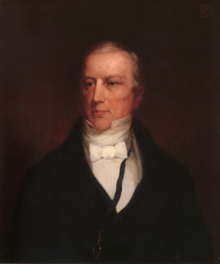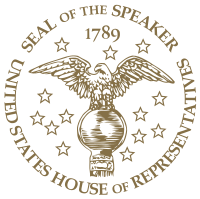Andrew Stevenson
Andrew Stevenson (January 21, 1784 – January 25, 1857) was a Democratic politician in the United States. He served in the United States House of Representatives representing Virginia, as Speaker of the House, and as Minister to the United Kingdom.
Andrew Stevenson | |
|---|---|
 | |
| United States Minister to the United Kingdom | |
| In office July 13, 1836 – October 21, 1841 | |
| Preceded by | Aaron Vail (as chargé d'affaires) |
| Succeeded by | Edward Everett |
| 11th Speaker of the United States House of Representatives | |
| In office December 3, 1827 – June 2, 1834 | |
| Preceded by | John W. Taylor |
| Succeeded by | John Bell |
| Member of the U.S. House of Representatives from Virginia's 11th district | |
| In office March 4, 1833 – June 2, 1834 | |
| Preceded by | John M. Patton |
| Succeeded by | John Robertson |
| Member of the U.S. House of Representatives from Virginia's 9th district | |
| In office March 4, 1825 – March 3, 1833 | |
| Preceded by | James Stephenson |
| Succeeded by | William P. Taylor |
| Member of the U.S. House of Representatives from Virginia's 16th district | |
| In office March 4, 1823 – March 3, 1825 | |
| Preceded by | John Randolph |
| Succeeded by | William Armstrong |
| Member of the U.S. House of Representatives from Virginia's 23rd district | |
| In office March 4, 1821 – March 3, 1823 | |
| Preceded by | John Tyler |
| Succeeded by | None; district eliminated |
| Member of the Virginia House of Delegates from Richmond City | |
| In office January 1819 – December 3, 1821 | |
| Preceded by | John Robertson |
| Succeeded by | Jacqueline B. Harvie |
| In office December 4, 1809 – November 11, 1816 | |
| Preceded by | William Wirt |
| Succeeded by | John Robertson |
| Personal details | |
| Born | January 21, 1784 Culpeper County, Virginia |
| Died | January 25, 1857 (aged 73) Albemarle County, Virginia |
| Political party | Democratic |
| Spouse(s) | Mary Page White (m. 1809; her death 1812) Sarah Coles (m. 1816; her death 1848) Mary Schaff (m. 1849; his death 1857) |
| Children | John White Stevenson |
| Alma mater | The College of William & Mary |
| Profession | Law |
Early life
Andrew Stevenson was born in Culpeper County, Virginia on January 21, 1784. He was the son of James Stevenson (1739–1809) and Frances Arnette (née Littlepage) Stevenson (1750–1808).
He was educated at the College of William and Mary, studied law, and attained admission to the bar in 1809. Stevenson practiced in Richmond.[1]
Career
Stevenson was a member of the Virginia House of Delegates from 1809 to 1816 and 1818 to 1821. He served as Speaker of the House of Delegates from 1812 to 1815. In 1814 and 1816, he was an unsuccessful candidate for Congress.[1]
U.S. Congress
In 1820, Stevenson won election to the 17th U.S. Congress as a Democratic-Republican. When the party fragmented during the contentious 1824 presidential election, he first aligned himself with the Crawford faction during the 18th Congress, and then, for the remainder of his time in Congress, identified with the Jacksonians.[1] He was elected Speaker of the House on December 3, 1827, the opening day of the 20th Congress. Reelected three times (1829, 1831 and 1833) he served until his resignation on June 2, 1834.[2]
Minister to the United Kingdom

In June 1834, Stevenson resigned from Congress to accept appointment from Andrew Jackson as Minister to the United Kingdom. In June of that year, the United States Senate denied him confirmation by a vote of 23 to 22.[3] Jackson's opponents in Congress argued that Jackson had offered Stevenson the appointment in 1833, and that when Congress convened later that year, Stevenson had organized the House, including committee assignments and chairmanships, in accordance with Jackson's preferences. In the Anti-Jacksonian view, this amounted to a quid pro quo that allowed executive branch interference with the prerogatives of the legislative branch. Following his denial by the Senate, he returned to Virginia and resumed the practice of law and in addition, he presided over the 1835 Democratic National Convention.[1]
In February 1836, President Andrew Jackson renominated Stevenson for Minister to Great Britain. The second time around, he was confirmed 26 votes to 19, and served from 1836 to 1841.[3]
His term as Minister to the United Kingdom was marked by controversy: the abolitionist cause was growing in strength, and some sections of public opinion resented the choice of Stevenson, who was a slaveowner, for this role.[4] The Irish statesman Daniel O'Connell was reported to have denounced Stevenson in public as a slave breeder, generally thought to be a more serious matter than simply being a slaveowner.[5] Stevenson, outraged, challenged O'Connell to a duel, but O'Connell, who had a lifelong aversion to dueling, refused, and suggested that he had been misquoted. The controversy became public and the repeated references to slave breeding caused Stevenson a good deal of embarrassment; there was a widespread view that if O'Connell's charges were false Stevenson would have done better to simply ignore them rather than engaging in a public squabble.[6]
Later life
In 1846, Stevenson purchased the Blenheim estate in Albemarle County, Virginia.[7] Blenheim was added to the National Register of Historic Places in 1976.[8]
Stevenson presided over the 1848 Democratic National Convention. In 1845 he was elected to the board of visitors of the University of Virginia. From 1856 to 1857, he served as the university's rector.[1]
Personal life
Stevenson married three times.[9] In 1809, he married Mary Page White, the granddaughter of Carter Braxton, a signer of the Declaration of Independence.[10] She died during childbirth in 1812, giving birth to:[11]
- John White Stevenson (1812–1886), a Congressman, U.S. Senator, and who also served as Governor of Kentucky. He married Sibella Winston (1823–1904) in 1843.[9]
In 1816, he married his second wife, Sarah "Sally" Coles (1789–1848), who was a cousin of Dolley Madison and a sister of Edward Coles, who served as Governor of Illinois. She died in 1848.[12] In 1849, he married for the third and final time to Mary Schaff.
Stevenson died at his Blenheim estate on January 21, 1857. He was buried at Enniscorthy Cemetery in Keene, Virginia.[13]
Notes
- Morton gives both Mary and John Stevenson's middle initials as "D." instead of "W." She also omits Samuel W. Stevenson from the list of children, including instead Andrew Stevenson of Philadelphia, Pennsylvania. She later writes that his son John White Stevenson was survived by six children, despite having previously listed only five names. Vaux (p. 14) lists sons Andrew and John, although he states that Andrew lives in Montana. Vaux also mentions three unnamed daughters.
References
- "STEVENSON, Andrew - Biographical Information". bioguide.congress.gov. Biographical Directory of the United States Congress. Retrieved 18 April 2018.
- "List of Speakers of the House". Washington, D.C.: Office of the Historian, U.S. House of Representatives. Retrieved March 4, 2019.
- "Andrew Stevenson - People - Department History". history.state.gov. Office of the Historian, Bureau of Public Affairs United States Department of State. Retrieved 18 April 2018.
- Geoghegan, Patrick M. Liberator- the Life and Death of Daniel O'Connell Gill and Macmillan 2010 Dublin p.202
- Geoghegan pp.202-4
- Geoghegan p.204
- Virginia Historic Landmarks Commission Staff (December 1975). "National Register of Historic Places Inventory/Nomination: Blenheim" (PDF). Archived from the original (PDF) on 2012-09-26. Retrieved 2013-05-17. and Accompanying photo Archived 2012-09-26 at the Wayback Machine
- "National Register Information System". National Register of Historic Places. National Park Service. July 9, 2010.
- Owen 2004, p. 98.
- Vaux 1886, p. 5.
- John White Stevenson 1936.
- Vaux 1886, p. 6.
- Wayland, Francis Fry (1949). Andrew Stevenson: Democrat and Diplomat, 1785-1857. University of Pennsylvania Press. ISBN 9781512820881. Retrieved 18 April 2018.
Bibliography
- "John White Stevenson". Dictionary of American Biography. New York City, New York: Charles Scribner's Sons. 1936. Retrieved August 24, 2012.
- Owen, Tom (2004). "John White Stevenson". In Harrison, Lowell H (ed.). Kentucky's Governors. Lexington, Kentucky: The University Press of Kentucky. ISBN 0-8131-2326-7.
- Vaux, Richard (1886). A Memorial of John W. Stevenson of Kentucky, Late President of the Association. Philadelphia, Pennsylvania: Allen, Lane, and Scott.
External links
- United States Congress. "Andrew Stevenson (id: S000891)". Biographical Directory of the United States Congress.
- Andrew Stevenson at Find a Grave
| U.S. House of Representatives | ||
|---|---|---|
| Preceded by John Tyler |
Member of the U.S. House of Representatives from Virginia's 23rd congressional district March 4, 1821 – March 3, 1823 (obsolete district) |
Succeeded by (none) |
| Preceded by William L. Ball |
Member of the U.S. House of Representatives from Virginia's 9th congressional district March 4, 1823 – March 3, 1833 |
Succeeded by William P. Taylor |
| Preceded by John M. Patton |
Member of the U.S. House of Representatives from Virginia's 11th congressional district March 4, 1833 – June 2, 1834 |
Succeeded by John Robertson |
| Political offices | ||
| Preceded by John W. Taylor |
Speaker of the U.S. House of Representatives December 3, 1827 – March 3, 1829; December 7, 1829 – March 3, 1831; December 5, 1831 – March 3, 1833 December 2, 1833 – June 2, 1834 |
Succeeded by John Bell |
| Diplomatic posts | ||
| Preceded by Aaron Vail (Chargé d'Affaires) |
U.S. Minister to Britain 1836–1841 |
Succeeded by Edward Everett |


